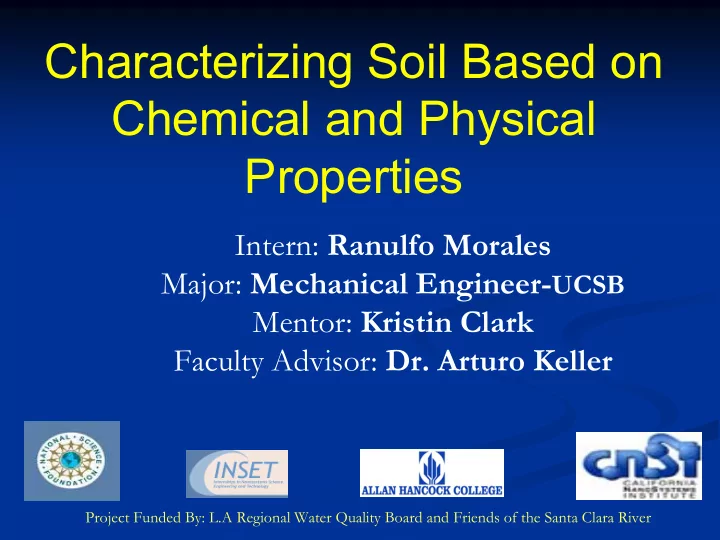

Characterizing Soil Based on Chemical and Physical Properties Intern: Ranulfo Morales Major: Mechanical Engineer- UCSB Mentor: Kristin Clark Faculty Advisor: Dr. Arturo Keller Project Funded By: L.A Regional Water Quality Board and Friends of the Santa Clara River
Background Background � Water quality improvement Water quality improvement � in the Santa Clara River. in the Santa Clara River. � Decrease pesticides and Decrease pesticides and � nutrients daily loads from nutrients daily loads from agriculture runoff into the agriculture runoff into the Santa Clara River. Santa Clara River. � Use bioswales and bioactive Use bioswales and bioactive � trenches to decontaminate trenches to decontaminate water as a low cost water as a low cost alternative. alternative.
Biotrenches and Bioswales Biotrenches and Bioswales Not to scale Bioswales Biotrenches 145 ft Flowmeter 14 ft G W well 165 ft Timer control valve Fertigater w/timer control valve 3 ft
My Contribution My Contribution � Understand a way to study the transport of Understand a way to study the transport of � nutrients and pesticides in the swales and trenches. nutrients and pesticides in the swales and trenches. � Transport processes: Transport processes: � - Adsorption Adsorption - - Advection Advection- -dispersion dispersion - � Characterize the physical properties of soils: Characterize the physical properties of soils: � - Bulk density Bulk density - - Moisture content Moisture content - - Specific gravity Specific gravity - - Particle size Particle size -
Overview Overview Preliminary Analysis Preliminary Analysis � Collect soil samples Collect soil samples � � Process using ASTM methods Process using ASTM methods � Methods Methods � Measure Specific Gravity, Soil Moisture, Hygroscopic Measure Specific Gravity, Soil Moisture, Hygroscopic � Moisture, Bulk density, % soil suspension Moisture, Bulk density, % soil suspension Analysis Analysis � Calculate particle size and texture Calculate particle size and texture �
Process Process 1 2 I5 M5 O5 1. Take soil samples I4 M4 O4 from Bioswales I3 M3 O3 2. Label and separate I2 M2 O2 samples in plate for I1 M1 O1 air drying. 3. Sieve in 2mm pan 4. Put other half of samples in Al. pan to oven dry 3 4
Methods Methods Measure Bulk Density Measure moisture content using the oven dried method Measure specific gravity of the soil relative to water
Methods and Apparatus Methods and Apparatus Plunger Hydrometer Data Soil Samples Book
Data Data Bulk Density (g/mL ) 1.6 1.4 Bulk Density (g/mL) 1.2 1 0.8 0.6 0.4 0.2 0 1 2 3 4 5 1 2 3 4 5 1 2 3 4 5 t t t t t t t t t t e e e e e u u u u u u u u u u l l l l l p p p p p p p p p p d d d d d n n n n n d d d d d t t t t t u u u u u i i i i i I I I I I M M M M M O O O O O Sample
Data Moisture Content 40 35 % Moisture 30 25 20 15 10 5 0 Input Sample Output Sample Middle Sample
Data Data Specific Gravity G_s = (K*M_s )/(M_s +M_pw @T_x – Mpws) 3.5 Input 1 Input 2 3 Input 3 Specific Gravity Input 4 2.5 Input 5 2 Output 1 Output 2 1.5 Output 3 Output 4 1 Output 5 0.5 Middle 1 Middle 2 0 Middle 3 G_s Middle 4 Input Samples Output Samples Middle Samples Sample Middle 5
Results Results Output 3 Sample (g) % Suspension time 2 min 4 hrs 4 hrs 7 Courtesy: USDA-Soil Texture 100-28=72%
What We Learned What We Learned * How to use the Hydrometer * Classify soil texture using USDA Soil Texture Triangle * Analyze the particle size of the different samples
Future Work Future Work * Characterize chemical properties: - Soil organic matter (SOM) - Dissolved organic matter (DOM) - Cation-exchange capacity (CEC) - Residual pesticides * Model lateral and vertical transport of ground water
Acknowledgments Acknowledgments Kristin Clark Dr. Arturo Keller Peng Wang Samantha Freeman Dr. Nick Arnold Liu-Yen Kramer Luke Bawazer Dr. Evelyn Hu Group B
QUESTIONS!!! http://maxweber.hunter.cuny.edu/pub/eres/EDSPC715_MCINTYRE/MonstersCartoon
Biotrenches and Bioswales Biotrenches and Bioswales Compost and mulch Compost and mulch Compost and mulch Compost and mulch Add “HRC” as needed Add “HRC” as needed Add “ORC” as needed Add “ORC” as needed Sampling well Sampling well GW flow GW flow 2.5 m 2.5 m aquitard aquitard 3 m 3 m 3 m 3 m 3 m 3 m
Recommend
More recommend